
Shikoku, Japanese pronunciation:[ɕikokɯ] is the smallest of the four main islands of Japan. It is 225 km or 139.8 mi long and between 50 and 150 km or 31.1 and 93.2 mi at its widest. It has a population of 3.8 million, the least populated of Japan's four main islands. It is south of Honshu and northeast of Kyushu. Shikoku's ancient names include Iyo-no-futana-shima (伊予之二名島), Iyo-shima (伊予島), and Futana-shima (二名島), and its current name refers to the four former provinces that make up the island: Awa, Tosa, Sanuki, and Iyo.
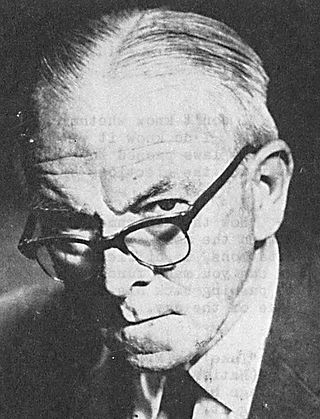
Alan Stewart Paton was a South African writer and anti-apartheid activist. His works include the novels Cry, the Beloved Country (1948), Too Late the Phalarope (1953), and the short story The Waste Land.

KwaZulu-Natal is a province of South Africa that was created in 1994 when the government merged the Zulu bantustan of KwaZulu and Natal Province.

Durban is the third-most populous city in South Africa, after Johannesburg and Cape Town, and the largest city in the province of KwaZulu-Natal. Situated on the east coast of South Africa, on the Natal Bay of the Indian Ocean, Durban is South Africa's busiest port and was formerly named Port Natal. North of the harbour and city centre lies the mouth of the Umgeni River; the flat city centre rises to the hills of the Berea on the west; and to the south, running along the coast, is the Bluff. Durban is the seat of the larger eThekwini Metropolitan Municipality, which spans an area of 2,556 km2 (987 sq mi) and had a population of 4.2 million in 2022, making the metropolitan population one of Africa's largest on the Indian Ocean. Within the city limits, Durban's population was 595,061 in 2011. The city has a humid subtropical climate, with hot, wet summers and mild, dry winters.

Ladysmith is a city in the Uthukela District of KwaZulu-Natal, South Africa. It lies 230 kilometres (140 mi) north-west of Durban and 365 kilometres (227 mi) south-east of Johannesburg. Important industries in the area include food processing, textiles, and tyre production. Ladysmith is the seat for both the Alfred Duma Local Municipality and Uthukela District Municipality.
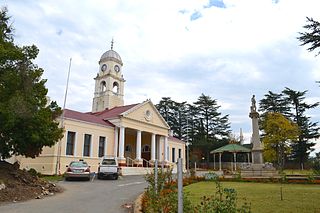
Kokstad is a town in the Harry Gwala District Municipality of KwaZulu-Natal Province, South Africa. Kokstad is named after the Griqua chief Adam Kok III who settled here in 1863. Kokstad is the capital town of the East Griqualand region, as it is also the biggest town in this region. It was built around Mount Currie, a local mountain range, by the town’s founder Adam Kok III, for whom the town is named. Stad is the Dutch and Afrikaans word for "city".
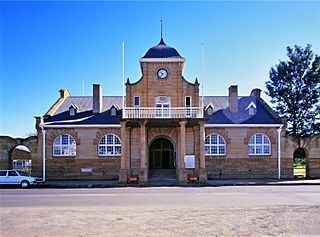
Utrecht is a town in the foothills of the Balele Mountains, in the northwestern corner of KwaZulu-Natal, South Africa. Newcastle, Kwazulu-Natal's third-largest urban centre, is 50 km from Utrecht. Utrecht has a population of approximately 32,000.

Himeville is a small village/town situated in the foothills of the picturesque Southern Drakensberg, KwaZulu-Natal, South Africa, approx 130 km from Pietermaritzburg. It is a landmark en route to the world-famous Sani Pass and the uKhahlamba Drakensberg Park. Himeville is the closest town to the Sani Pass which links the town with Mokhotlong in Lesotho.

Amanzimtoti, locally nicknamed Toti, and officially renamed to eManzimtoti, is a coastal town just south of Durban in KwaZulu-Natal, South Africa. Situated along the Sapphire Coast, the town is well known for its warm climate and numerous beaches, and is a popular tourist destination, particularly with surfers.
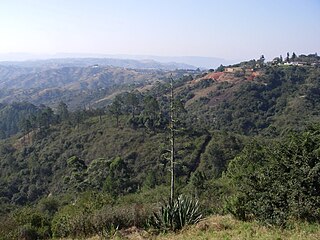
The Valley of a Thousand Hills is a valley between Pietermaritzburg and Durban, South Africa. The Umgeni River meets the Msunduzi River in the valley, and the Dusi Canoe Marathon is run through the area every year.

Lewis Nkosi was a South African writer and journalist, who spent 30 years in exile as a consequence of restrictions placed on him and his writing by the Suppression of Communism Act and the Publications and Entertainment Act passed in the 1950s and 1960s. A multifaceted personality, he attempted multiple genre for his writing, including literary criticism, poetry, drama, novels, short stories, essays, as well as journalism.

Matsuyama is the capital city of Ehime Prefecture, on the island of Shikoku, in Japan and is also Shikoku's largest city. As of 1 October 2022, the city had an estimated population of 505,948 in 243,541 households and a population density of 1200 persons per km2. The total area of the city is 429.35 square kilometres (165.77 sq mi).

uMhlanga, alternatively rendered Umhlanga, is a residential, commercial and resort town north of Durban on the coast of KwaZulu-Natal, South Africa. It is part of the eThekwini Metropolitan Municipality, which was created in 2000 and includes the greater Durban area. The name means "place of reeds" in the Zulu language, and the correct pronunciation of "hl" in uMhlanga is similar to the Welsh "ll".
Marguerite Poland OIS is a South African writer and author of eleven children's books.
Tourism fiction is a genre of fiction that is written to generate tourism to specific areas and places. This is done by setting the fiction in real attractions and including short travel guides within the story showing readers how to visit the real places.
Amafa aKwaZulu-Natali, commonly known as 'Amafa', is a provincial heritage resources authority in terms of South Africa's National Heritage Resources Act. It was established in 1997 in terms of the KwaZulu-Natal Heritage Act of that year and is an agency of the Office of the Premier of the government of the KwaZulu-Natal Province of South Africa. It is also a 'public entity' under the terms of the Public Finance Management Act. It is mandated to care for that part of South Africa's national estate that is of provincial and local significance in KwaZulu-Natal.

Writers' homes are locations where writers lived. Frequently, these homes are preserved as historic house museums and literary tourism destinations, called writer's home museums, especially when the homes are those of famous literary figures. Frequently these buildings are preserved to communicate to visitors more about the author than their work and its historical context. These exhibits are a form of biographical criticism. Visitors of the sites who are participating in literary tourism, are often fans of the authors, and these fans find deep emotional and physical connections to the authors through their visits.

KZN Literary Tourism is a literary tourism research project initiated in 2002 by Professor Lindy Stiebel, a lecturer in the English Studies department at the University of KwaZulu-Natal. The project has created an online archive of over 100 writers linked to the KwaZulu-Natal province, collected reviews of local literature, conducted interviews of local authors, promoted local literary events such as Time of the Writer and investigated “the links between literature and tourism in scholarly colloquia and publications”. The project has also been responsible for creating eight writer trails which attempt to connect writers, their works and place within the province.
Sally-Ann Murray is an author from South Africa.
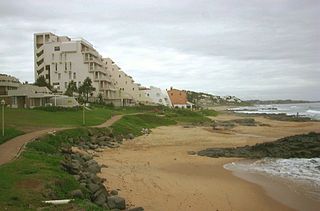
The KwaZulu-Natal North Coast, better known as the North Coast is a coastal region north of Durban in KwaZulu-Natal, South Africa. It stretches from Zinkwazi Beach in the north to Zimbali near Ballito in the south. The coastal region is governed by the KwaDukuza Local Municipality, forming part of the iLembe District Municipality.

















